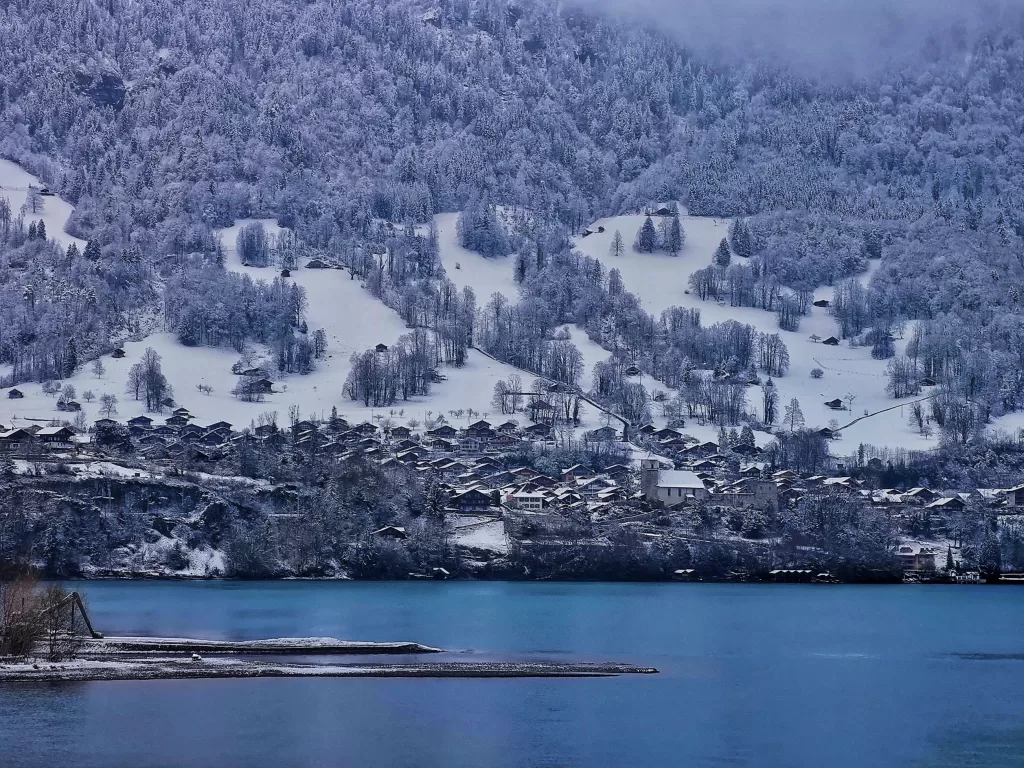 The Jungfrau Region, named after its highest mountain Jungfrau, is one of Switzerland’s most famous tourist destinations. My acquaintance with this destination was unexpected but lucky. I had never heard of it when choosing the area for an early April trip – I simply spotted the two lakes surrounded by the Alps on Google Maps.
The Jungfrau Region, named after its highest mountain Jungfrau, is one of Switzerland’s most famous tourist destinations. My acquaintance with this destination was unexpected but lucky. I had never heard of it when choosing the area for an early April trip – I simply spotted the two lakes surrounded by the Alps on Google Maps.
Best time to visit: From late Spring to Winter
It was only after my visit that I grasped the extent of the area’s fame. The region is a winter wonderland for ski enthusiasts, while summer peaks with Asian tourists taking Instagram-worthy photos. I regret not researching more on social media beforehand about possible activities – it could have further enriched our experience.
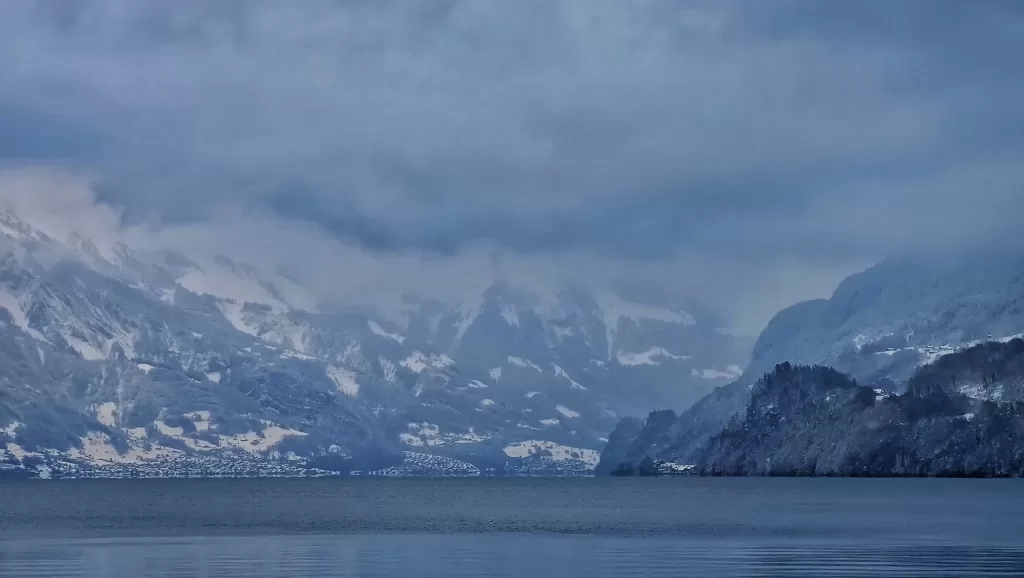
My husband and I booked a short three-day, two-night trip. The itinerary was to spend our first night in Wilderswil, venturing into the mountains by train during the day. Then, we’d relocate to Bönigen, next to the picturesque Brienzersee (Lake Brienz), and set off on a hiking journey.
Day 1:
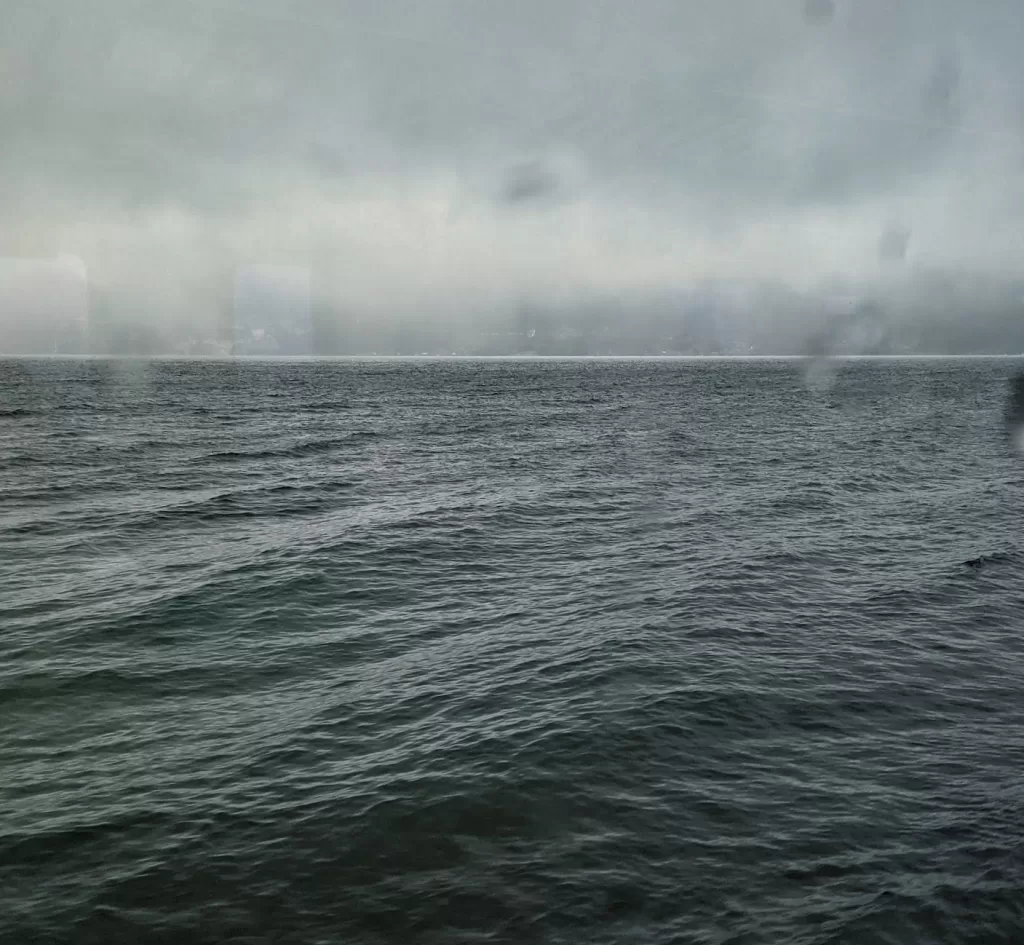 We made our way from Paris to Basel, where we spent the night before the main leg of our trip. Remember, Switzerland is not part of the EU or EEA, so your EU SIM plan might not work there. Check with your provider to avoid connection or billing surprises.
We made our way from Paris to Basel, where we spent the night before the main leg of our trip. Remember, Switzerland is not part of the EU or EEA, so your EU SIM plan might not work there. Check with your provider to avoid connection or billing surprises.
Our train went from Basel to Interlaken West. For various train schedules, see SBB Official Website. In early April 2022 we had freezing weather: snow starting to fall just before we reached Bern. The snow intensified on our way to Interlaken, which was quite a treat for me, especially in April! Thunersee, under the snowy veil, resembled a sea more than a lake.
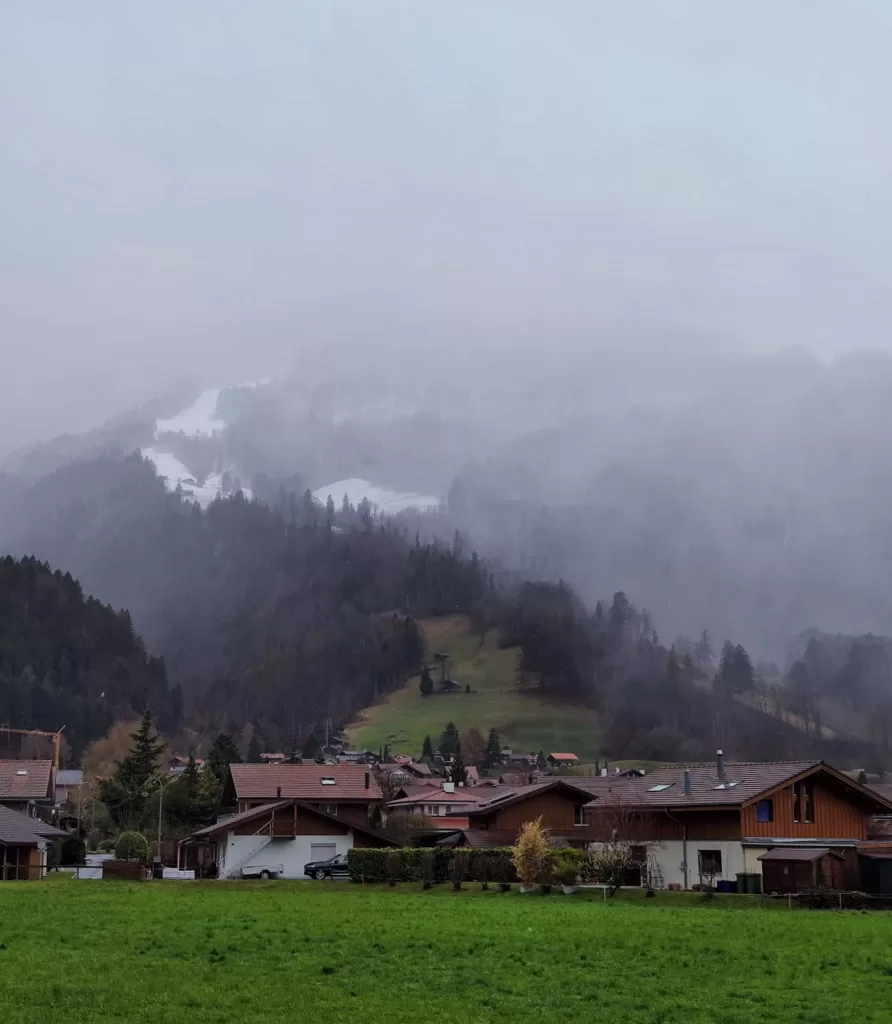 We stayed in Wilderswil, taking a bus from Interlaken West. It’s common for hotels in touristy areas of German-speaking regions to offer a free transportation card for local public transit (excluding mountain trains), which is a great perk. It would be great if hotels in the US, like in New York with their resort fees, offered something similar.
We stayed in Wilderswil, taking a bus from Interlaken West. It’s common for hotels in touristy areas of German-speaking regions to offer a free transportation card for local public transit (excluding mountain trains), which is a great perk. It would be great if hotels in the US, like in New York with their resort fees, offered something similar.
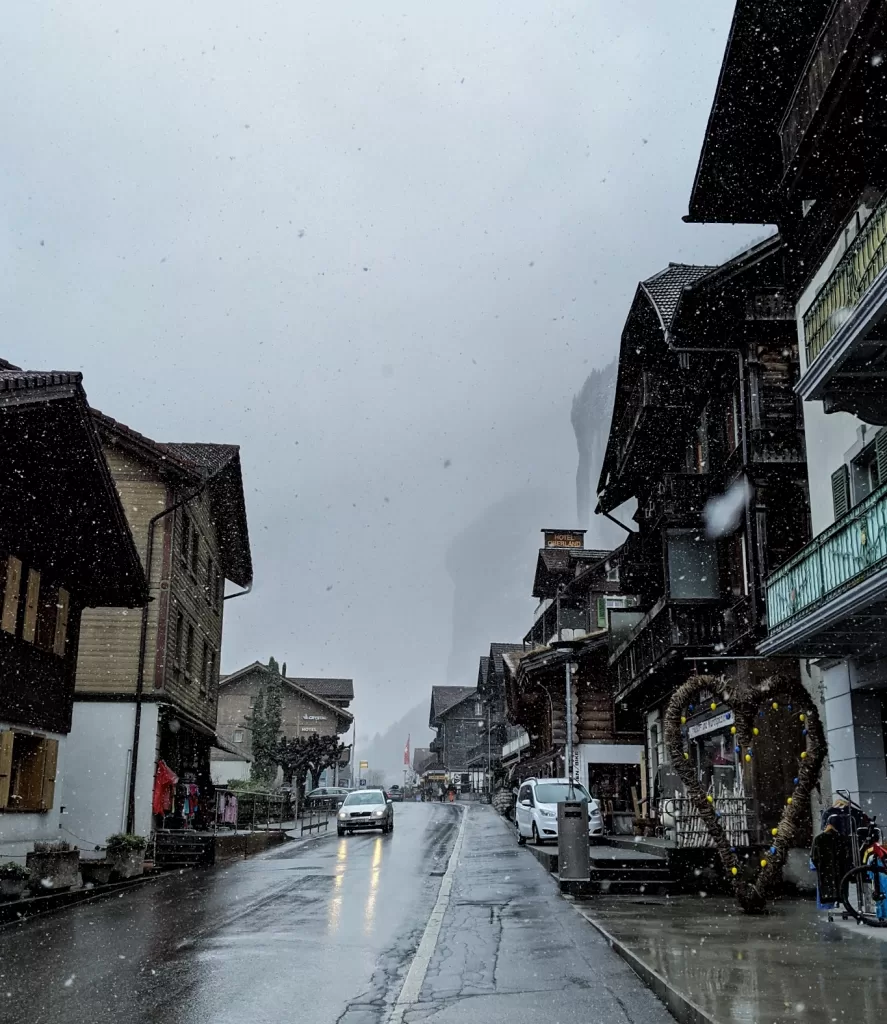 The contrast of snowy mountains and green valleys was enchanting, like something from a fairy tale. Our next stop was Lauterbrunnen, a cliff-ringed valley town with waterfalls nearby. It was only after spotting it on Instagram that I realized it was a place I had longed to visit – a town with a waterfall cascading above it. Although the waterfalls were less impressive due to the cold and low clouds, I was satisfied with the snow – better than rain!
The contrast of snowy mountains and green valleys was enchanting, like something from a fairy tale. Our next stop was Lauterbrunnen, a cliff-ringed valley town with waterfalls nearby. It was only after spotting it on Instagram that I realized it was a place I had longed to visit – a town with a waterfall cascading above it. Although the waterfalls were less impressive due to the cold and low clouds, I was satisfied with the snow – better than rain!
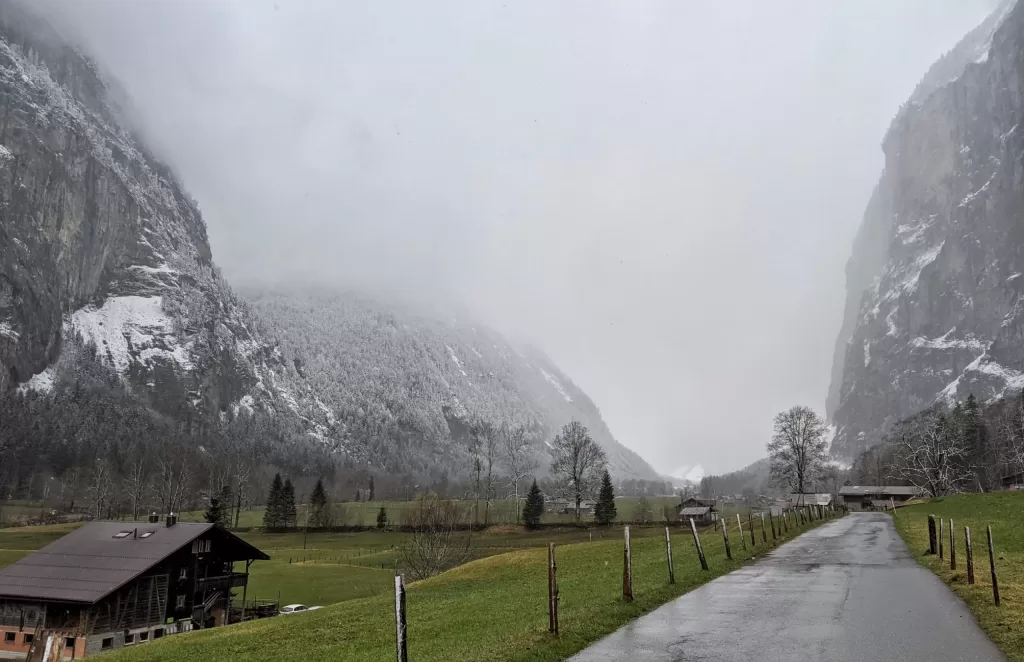
In Lauterbrunnen, heading left from the train station leads to the waterfalls along the main road, and eventually, a trail. We chose a different route back, crossing a bridge to find a parallel path by the river.
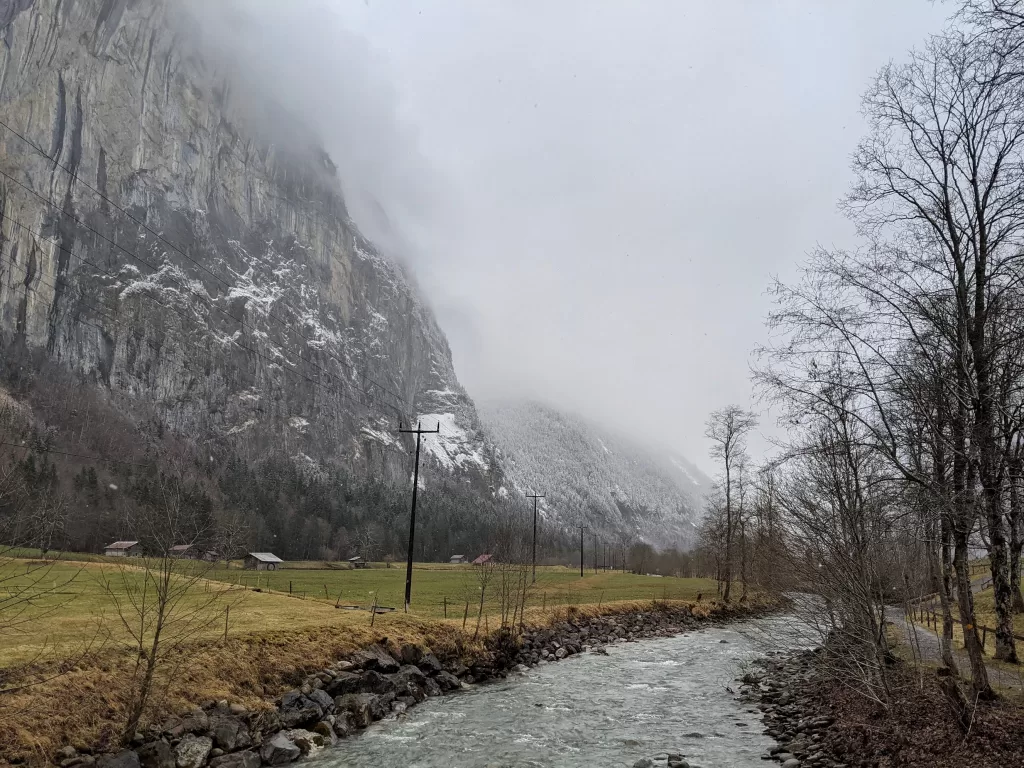
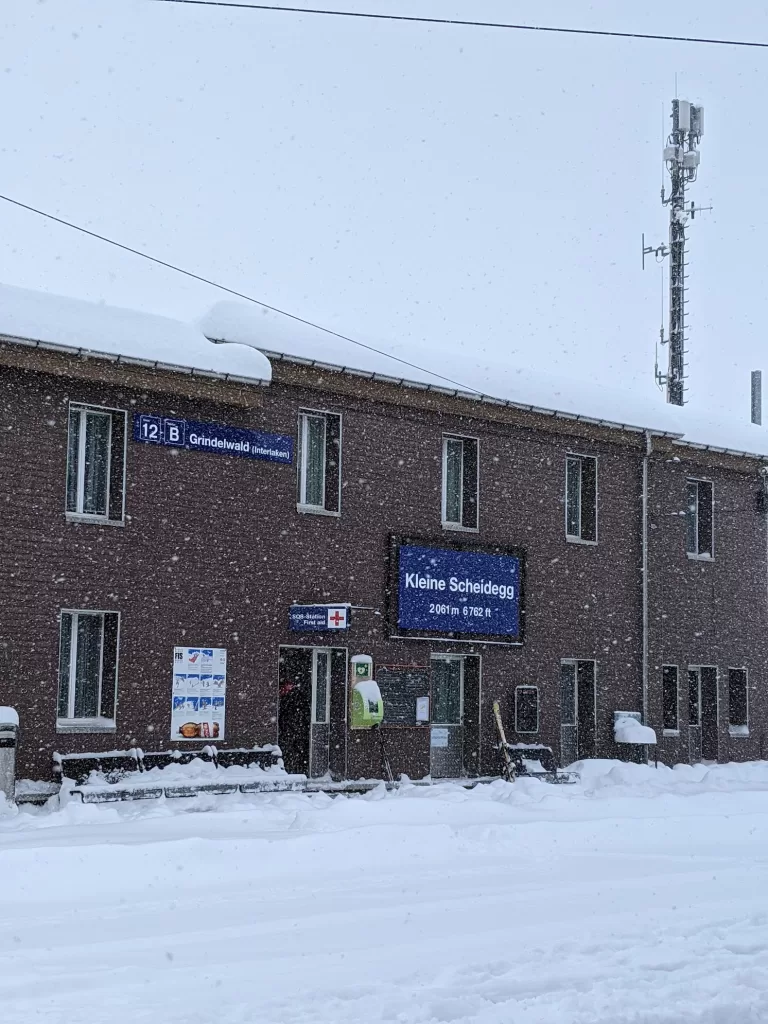 Then we ascended to Kleine Scheidegg, where the cogwheel train climbed into a whiteout of snow. Upon arrival, all we saw was snow and skiers, and it was biting cold. Thankfully, there was still a train down, so we were not stranded.
Then we ascended to Kleine Scheidegg, where the cogwheel train climbed into a whiteout of snow. Upon arrival, all we saw was snow and skiers, and it was biting cold. Thankfully, there was still a train down, so we were not stranded.
On the ascent previously, we happened to notice the town of Wengen, close to Lauterbrunnen and easy to return from, so we decided to stop there for dinner.
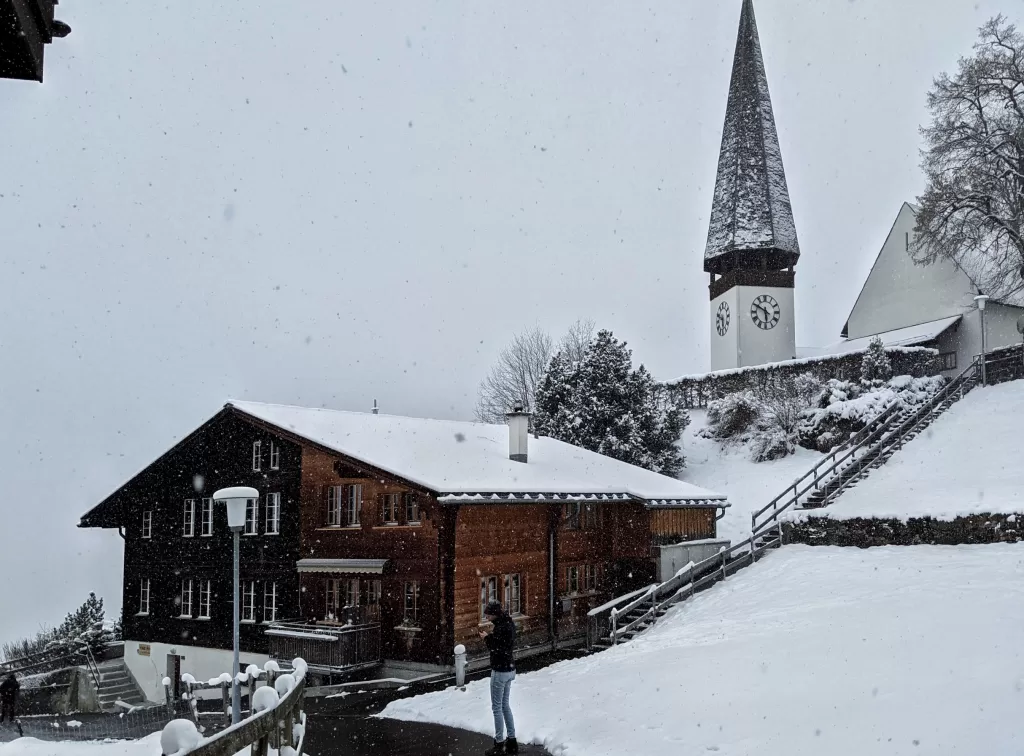 Wengen is exactly the kind of town where I could settle down: halfway up a mountain, small but with all the essentials, and above all, it was beautiful. The main street branched into smaller lanes, revealing that the town’s true beauty lay in the less-traveled routes. I’ve always preferred small towns to big cities – they’re where I can truly find peace. The hectic pace of urban areas where I grew up makes me savor the peacefulness that comes with living in a small town.
Wengen is exactly the kind of town where I could settle down: halfway up a mountain, small but with all the essentials, and above all, it was beautiful. The main street branched into smaller lanes, revealing that the town’s true beauty lay in the less-traveled routes. I’ve always preferred small towns to big cities – they’re where I can truly find peace. The hectic pace of urban areas where I grew up makes me savor the peacefulness that comes with living in a small town.
Day 2:
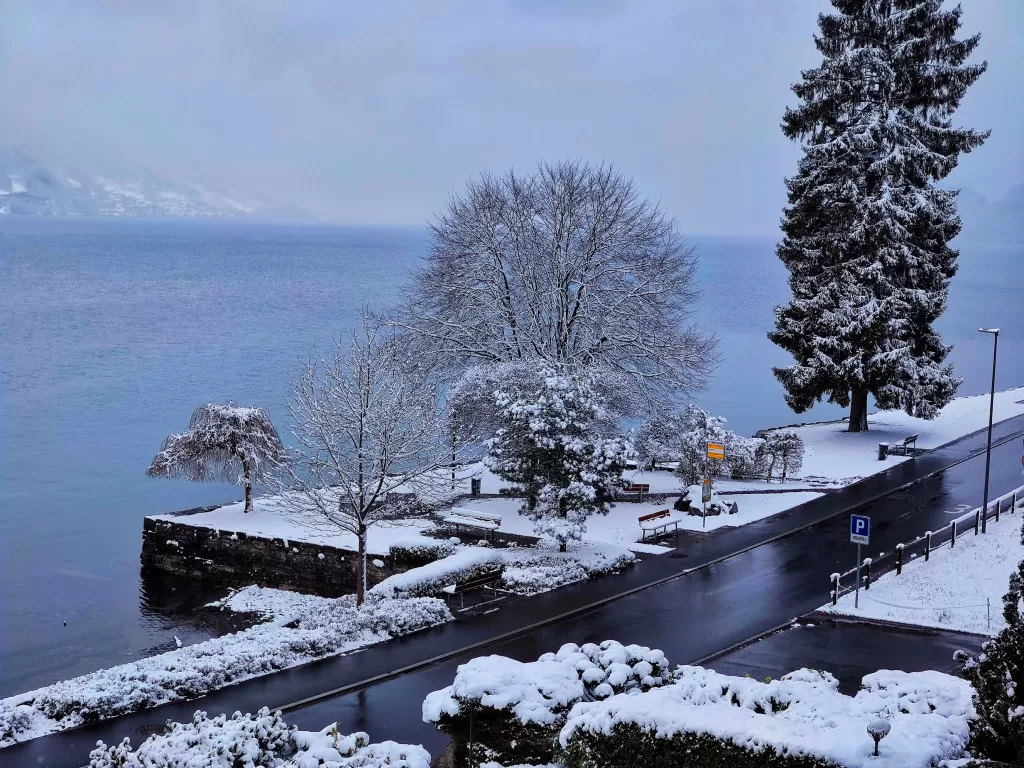 The view from our hotel room in Bönigen was postcard-perfect, with a broad balcony overlooking the serene Brienzersee and the mountains beyond.
The view from our hotel room in Bönigen was postcard-perfect, with a broad balcony overlooking the serene Brienzersee and the mountains beyond.
At a bus stop near our hotel, there was a charming little deck surrounded by trees that extended into the lake. With the snow that day, it reminded me of the classic Chinese imagery of a solitary fisherman in a snow-lined river. Since it was still morning, we took a leisurely walk around the lake’s edge. The lake narrows towards Interlaken, providing a perfect vantage point for photos of Bönigen from its piers.
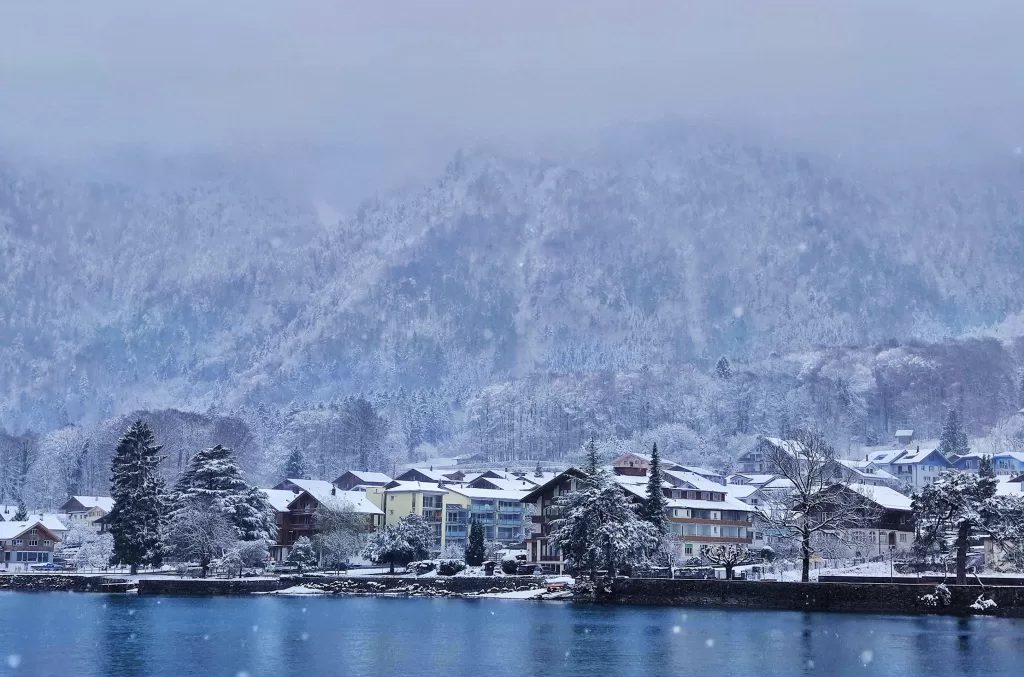
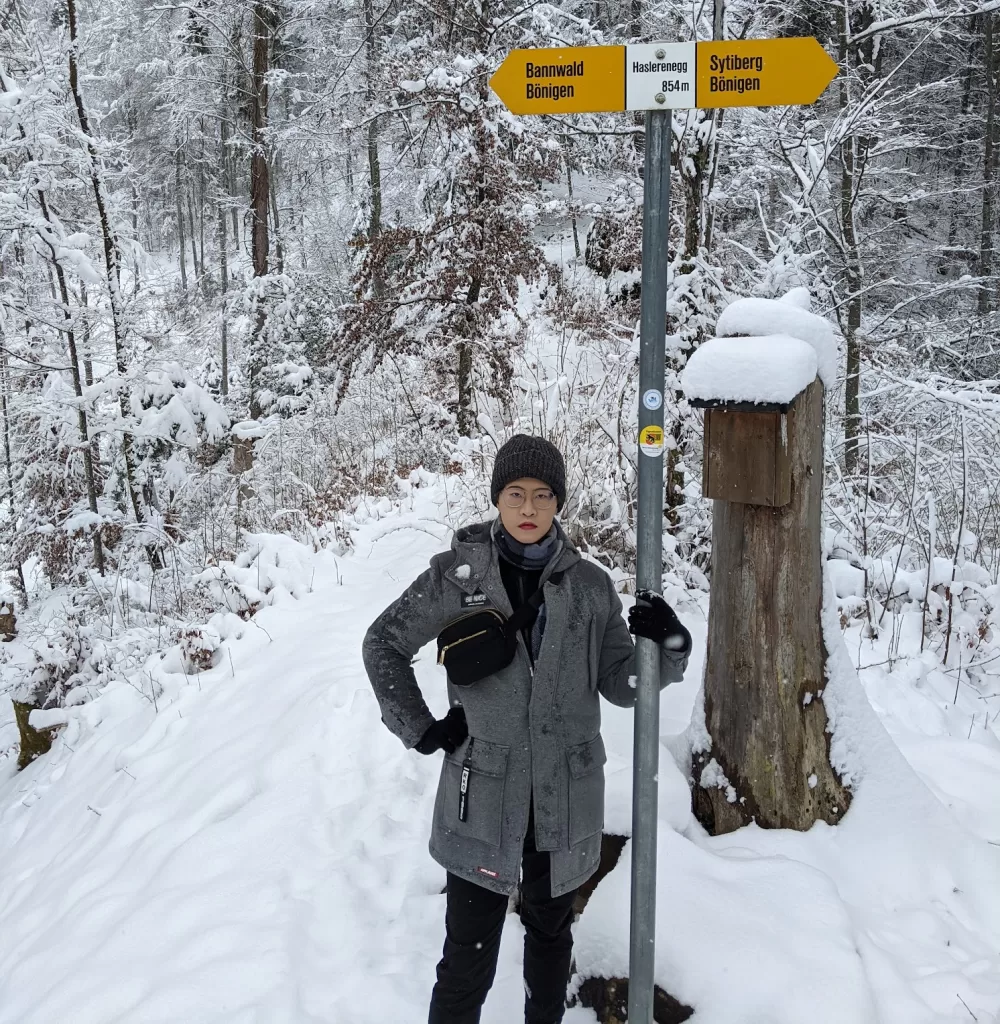 In the afternoon, we set off for a hike in the mountains – a must in the Alps! The hike was more leisurely than the hike in Schwangau that Rachel and I did – the paths were wide and the paths were moderately covered with snow. We encountered an elderly couple with their grandchild, which really highlighted the Swiss affinity for nature. The hike up to the top of Haslerenegg took some time, and we paused there to enjoy the view and catch our breath before descending.
In the afternoon, we set off for a hike in the mountains – a must in the Alps! The hike was more leisurely than the hike in Schwangau that Rachel and I did – the paths were wide and the paths were moderately covered with snow. We encountered an elderly couple with their grandchild, which really highlighted the Swiss affinity for nature. The hike up to the top of Haslerenegg took some time, and we paused there to enjoy the view and catch our breath before descending.
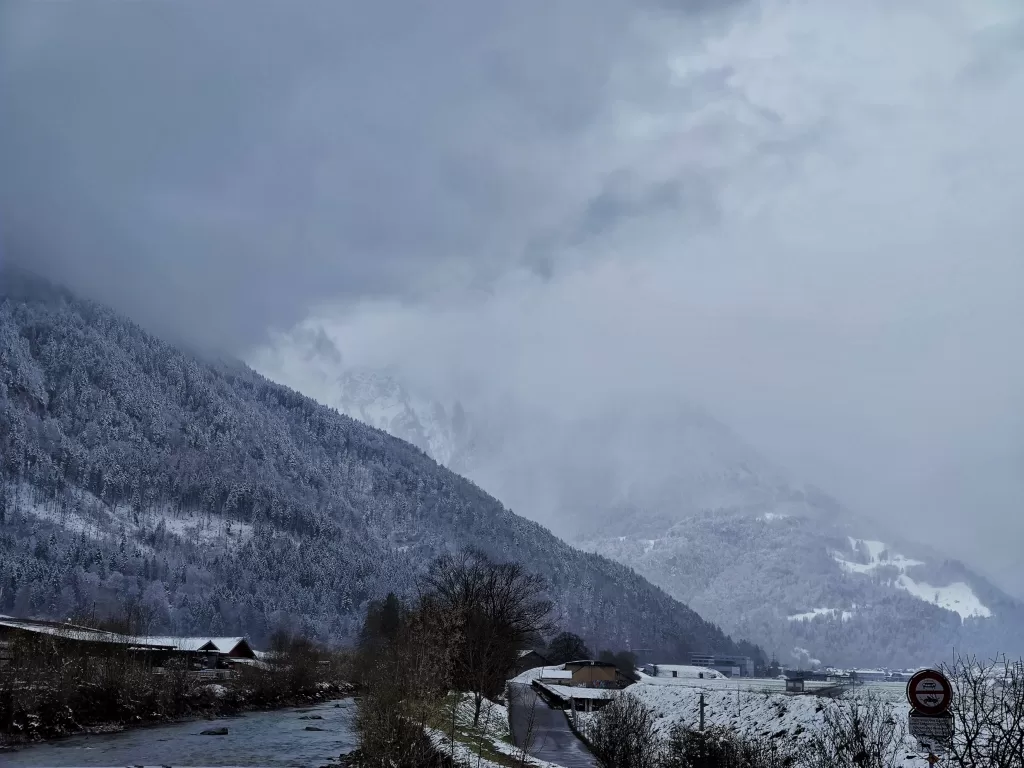 There were two potential routes for our descent, but the one we initially chose was too steep and slippery with snow. We had to retrace our steps for safety reasons. Along the way, curiosity led us to explore another steep path, which we eventually abandoned for the same reasons. We eventually found a gentler path down on the opposite side of the town, which brought us close to Interlaken. This last stretch was less thrilling as we were far from Bönigen and without bus options, so we walked on level ground. Luckily, a small stream offered a scenic route and a more enjoyable conclusion to our hike.
There were two potential routes for our descent, but the one we initially chose was too steep and slippery with snow. We had to retrace our steps for safety reasons. Along the way, curiosity led us to explore another steep path, which we eventually abandoned for the same reasons. We eventually found a gentler path down on the opposite side of the town, which brought us close to Interlaken. This last stretch was less thrilling as we were far from Bönigen and without bus options, so we walked on level ground. Luckily, a small stream offered a scenic route and a more enjoyable conclusion to our hike.
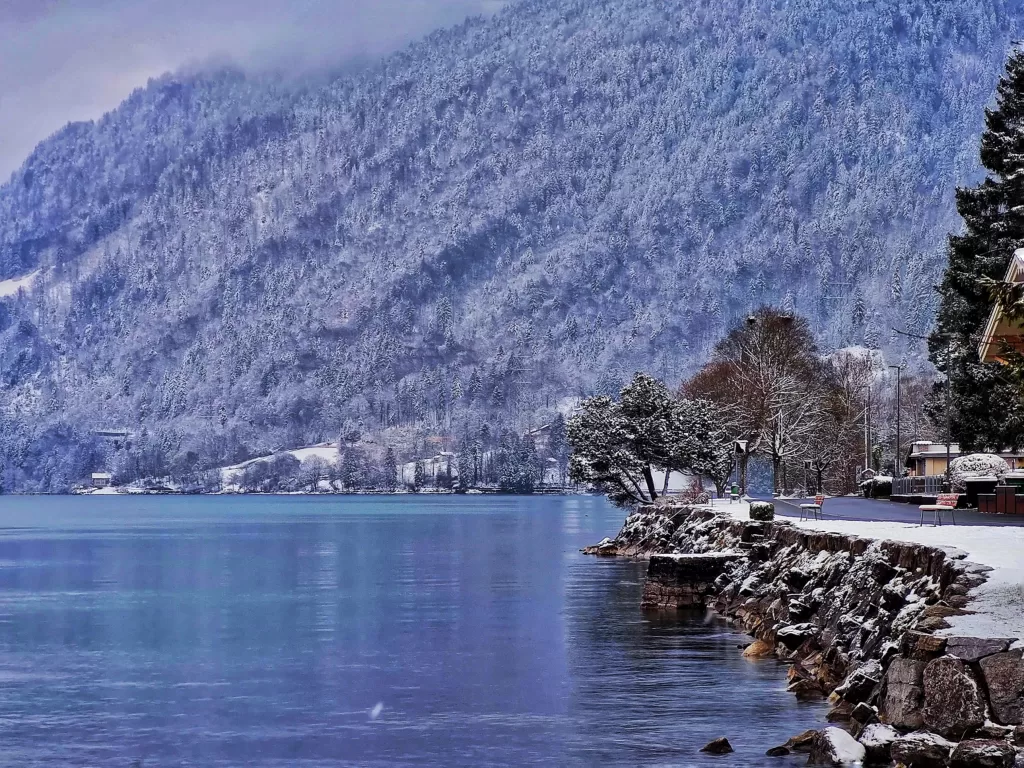 This trip was somewhat spontaneous, particularly the hiking aspect, but we made the most of our pre-booked plans and the weather conditions. Although Grindelwald would have been ideal for hiking and views, at that time, it was likely to be just a snowy expanse.
This trip was somewhat spontaneous, particularly the hiking aspect, but we made the most of our pre-booked plans and the weather conditions. Although Grindelwald would have been ideal for hiking and views, at that time, it was likely to be just a snowy expanse.
Switzerland’s trip was extraordinary, and we felt fortunate to have avoided staying in the mountains during a heavy snowfall. Switzerland’s mysterious snow-veiled beauty made it a place worthy of multiple visits throughout a lifetime to fully appreciate its varying magnificence across the seasons.
Jungfrau Region: Alpine Wonders Between Lakes and Peaks

The Jungfrau Region, named after its highest mountain Jungfrau, is one of Switzerland’s most famous tourist destinations. My acquaintance with this destination was unexpected but lucky. I had never heard of it when choosing the area for an early April trip – I simply spotted the two lakes surrounded by the Alps on Google Maps.
Best time to visit: From late Spring to Winter
It was only after my visit that I grasped the extent of the area’s fame. The region is a winter wonderland for ski enthusiasts, while summer peaks with Asian tourists taking Instagram-worthy photos. I regret not researching more on social media beforehand about possible activities – it could have further enriched our experience.

My husband and I booked a short three-day, two-night trip. The itinerary was to spend our first night in Wilderswil, venturing into the mountains by train during the day. Then, we’d relocate to Bönigen, next to the picturesque Brienzersee (Lake Brienz), and set off on a hiking journey.
Day 1:

We made our way from Paris to Basel, where we spent the night before the main leg of our trip. Remember, Switzerland is not part of the EU or EEA, so your EU SIM plan might not work there. Check with your provider to avoid connection or billing surprises.
Our train went from Basel to Interlaken West. For various train schedules, see SBB Official Website. In early April 2022 we had freezing weather: snow starting to fall just before we reached Bern. The snow intensified on our way to Interlaken, which was quite a treat for me, especially in April! Thunersee, under the snowy veil, resembled a sea more than a lake.
We stayed in Wilderswil, taking a bus from Interlaken West. It’s common for hotels in touristy areas of German-speaking regions to offer a free transportation card for local public transit (excluding mountain trains), which is a great perk. It would be great if hotels in the US, like in New York with their resort fees, offered something similar.
The contrast of snowy mountains and green valleys was enchanting, like something from a fairy tale.

Our next stop was Lauterbrunnen, a cliff-ringed valley town with waterfalls nearby. It was only after spotting it on Instagram that I realized it was a place I had longed to visit – a town with a waterfall cascading above it.

Although the waterfalls were less impressive due to the cold and low clouds, I was satisfied with the snow – better than rain!

In Lauterbrunnen, heading left from the train station leads to the waterfalls along the main road, and eventually, a trail. We chose a different route back, crossing a bridge to find a parallel path by the river.

Then we ascended to Kleine Scheidegg, where the cogwheel train climbed into a whiteout of snow. Upon arrival, all we saw was snow and skiers, and it was biting cold. Thankfully, there was still a train down, so we were not stranded.

On the ascent previously, we happened to notice the town of Wengen, close to Lauterbrunnen and easy to return from, so we decided to stop there for dinner.

Wengen is exactly the kind of town where I could settle down: halfway up a mountain, small but with all the essentials, and above all, it was beautiful. The main street branched into smaller lanes, revealing that the town’s true beauty lay in the less-traveled routes. I’ve always preferred small towns to big cities – they’re where I can truly find peace. The hectic pace of urban areas where I grew up makes me savor the peacefulness that comes with living in a small town.
Day 2:
The view from our hotel room in Bönigen was postcard-perfect, with a broad balcony overlooking the serene Brienzersee and the mountains beyond.
At a bus stop near our hotel, there was a charming little deck surrounded by trees that extended into the lake. With the snow that day, it reminded me of the classic Chinese imagery of a solitary fisherman in a snow-lined river.

Since it was still morning, we took a leisurely walk around the lake’s edge. The lake narrows towards Interlaken, providing a perfect vantage point for photos of Bönigen from its piers.

In the afternoon, we set off for a hike in the mountains – a must in the Alps! The hike was more leisurely than the hike in Schwangau that Rachel and I did – the paths were wide and the paths were moderately covered with snow. We encountered an elderly couple with their grandchild, which really highlighted the Swiss affinity for nature. The hike up to the top of Haslerenegg took some time, and we paused there to enjoy the view and catch our breath before descending.

There were two potential routes for our descent, but the one we initially chose was too steep and slippery with snow. We had to retrace our steps for safety reasons. Along the way, curiosity led us to explore another steep path, which we eventually abandoned for the same reasons. We eventually found a gentler path down on the opposite side of the town, which brought us close to Interlaken. This last stretch was less thrilling as we were far from Bönigen and without bus options, so we walked on level ground. Luckily, a small stream offered a scenic route and a more enjoyable conclusion to our hike.

This trip was somewhat spontaneous, particularly the hiking aspect, but we made the most of our pre-booked plans and the weather conditions. Although Grindelwald would have been ideal for hiking and views, at that time, it was likely to be just a snowy expanse.

Switzerland’s trip was extraordinary, and we felt fortunate to have avoided staying in the mountains during a heavy snowfall. Switzerland’s mysterious snow-veiled beauty made it a place worthy of multiple visits throughout a lifetime to fully appreciate its varying magnificence across the seasons.